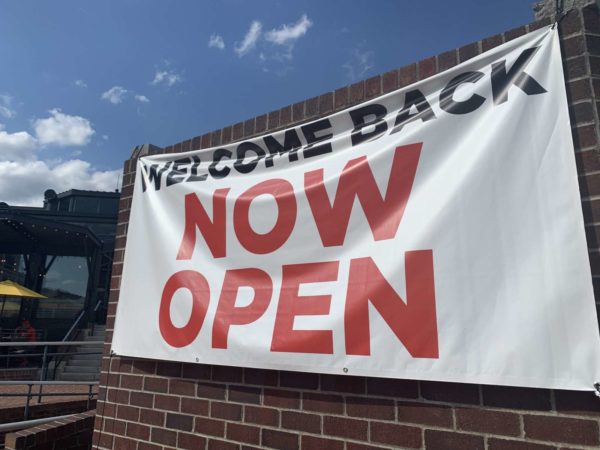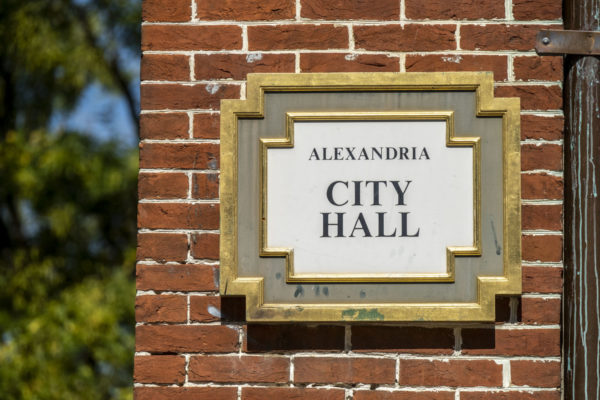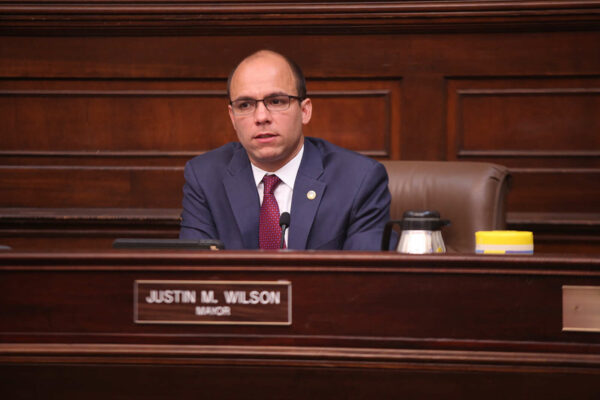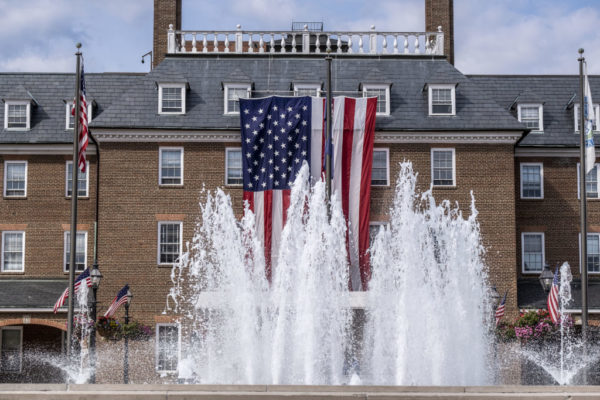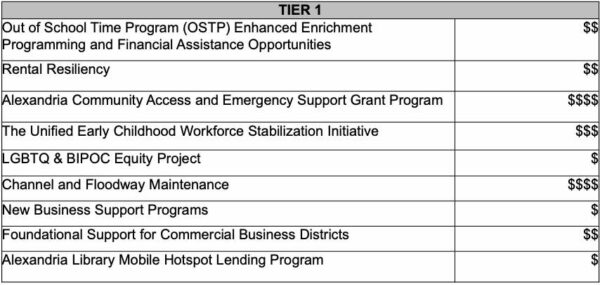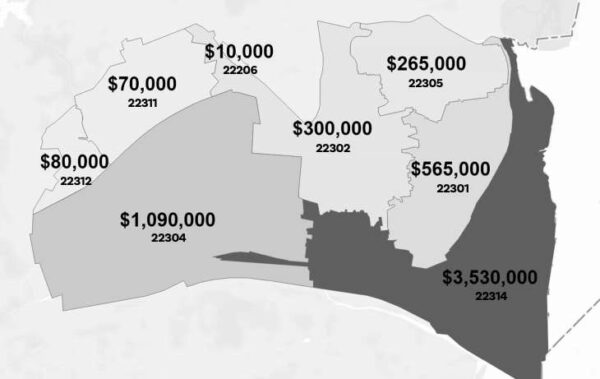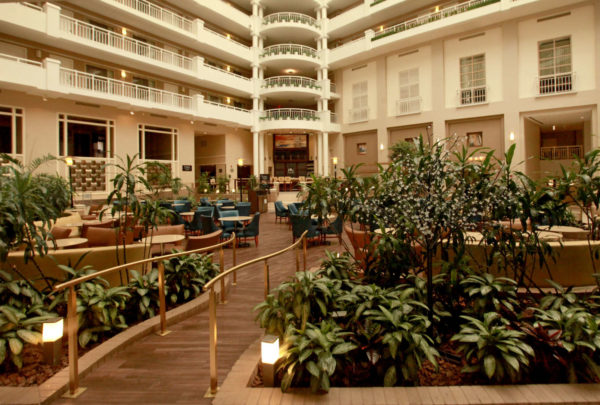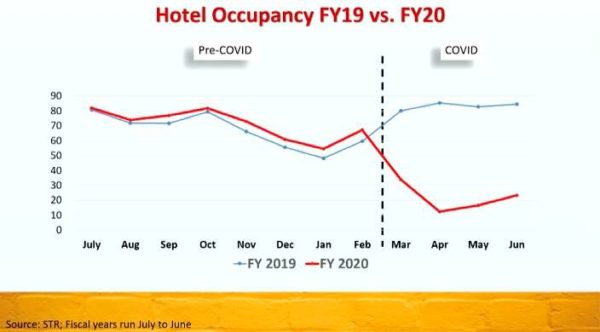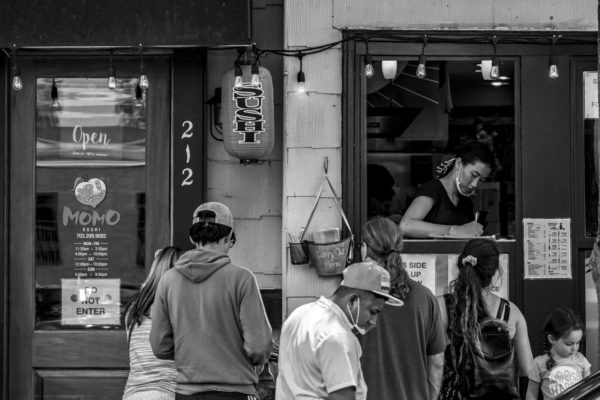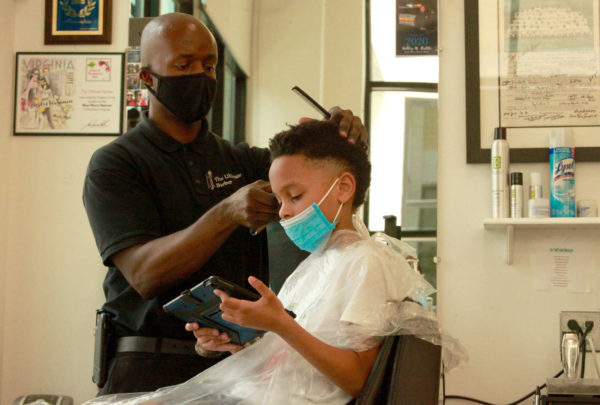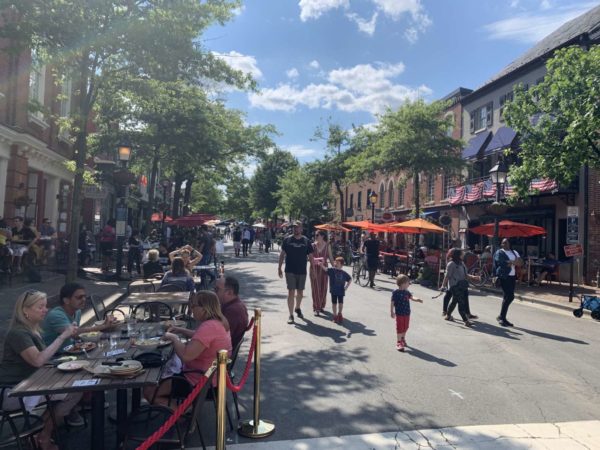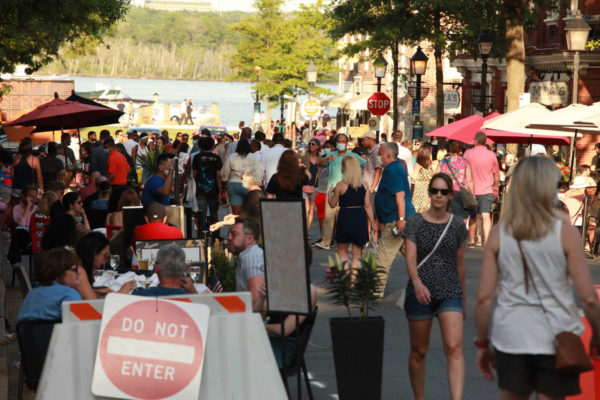(Updated 3:15 p.m.) As part of an ongoing mission to help boost the city’s economic recovery, a Virginia program being administered locally by the Alexandria/Arlington Regional Workforce Council offer to match signing bonuses for small, local businesses currently hiring new employees.
Liz Bolton, interim director of marketing and communications for the Alexandria Economic Development Partnership, said the grants are available to any business with fewer than 100 employees in Arlington or Alexandria. The grant program provides matching grants of $500 to create a $1,000 bonus for the new W-2 employees who are paid $15 per hour or more.
The bonus is applicable for any employee hired after May 31 up to a maximum of 25 new hires.
“Employer must match the full amount and provide funds directly to new hires,” the program website said. “This can be in either one lump sum or in installments to cover the ongoing costs of childcare, transportation, or other barriers to re-employment. Verification of how funds are used by the new hire is not required.”
Arlington and Alexandria employers can apply for the grants online.
Alexandria will spend millions on emergency financial support programs, stormwater repair, childcare and dozens of other projects as part of its first portion of American Rescue Plan Act funding.
“Now the really hard work begins,” Mayor Justin Wilson said after Council’s unanimous passage of a plan Tuesday night. “I think this is an opportunity to make some transformational investments.”
The City received its first $29.8 million on May 17, and has to spend the total $59.6 million in funding by Dec. 31, 2024. Alexandria is getting substantial funding by being counted as both a city and county — along with 41 other cities across the country — and will get its second allotment in May 2022.
Federal funds will not directly go to individual businesses, but some are allocated toward the funding of business districts for trial street closures, ABC-licensed special events and public access parklets.
“Our thought was that direct assistance for businesses was best provided, and continues to be provided, through the federal government at scale,” Alexandria Economic Development Partnership CEO Stephanie Landrum told Council. “We are much better equipped as a community, and certainly as an economic development group to reach a wider swath of businesses than we ever have been. And so part of our challenge and responsibility is to make sure all of those businesses know about other programs not being provided by the city.”
The 30 projects include:
- $4 million for an Alexandria Community Access and Emergency Support program to determine which city services are eligible for residents, including emergency financial aid, rent assistance and child care
- $3.7 million in stormwater repairs at the Hoofs Run Culvert
- $3 million for a Guaranteed Basic Income Pilot, which will give $500 in gift cards to 150 poor families for 24 months
- $2.8 million for a Unified Early Childhood Workforce Stabilization Initiative to “support hundreds of childcare providers and early childhood educators, provide a safe and healthy learning environment for thousands of children, and help parents, especially women, get back to work.”
- $2.5 million for food security to ensure two years of continual free food distributions at hubs throughout the city
- $2 million for Alexandria Housing Development Corporation flex space to expand city services for the Arlandria neighborhood
- $1.9 million in flash flooding spot improvements throughout the city
- $1.1 million to scale up a workforce development pilot
- $800,000 to make permanent the closure of the 100 block of King Street
- $620,000 to fund the Out of School Time Program to help with learning loss associated with the pandemic
- $560,000 to the Alexandria Economic Development Authority fund commercial business districts for trial street closures, ABC-licensed special events and public access parklets
- $500,000 for Visit Alexandria marketing efforts
- $295,000 to fund two new Office of Historic Alexandria tourism experiences on the city’s history with civil rights and and the Duke Street Corridor
- $253,000 to increase services for LGBTQ and BIPOC communities
Alexandria is planning on spending a portion of its American Rescue Plan Act funding on supporting a childcare wellness program, commercial business districts around the city, flooding mitigation and hiring bilingual city staffers to help residents facing eviction.
Those are just four of nine prioritized recommendations that the Alexandria City Council received Wednesday night on how to spend its first tranche of funding. After getting more than 1,300 recommendations from the community, spending has been categorized into tiers, with projects scored by staff. The Tier 1 and 2 projects would be handled with the first allocation, followed by the Tiers 3 and 4 with the second.
“This is a fast-moving but very, very significant effort that the City has been undertaking the last several months,” said Mayor Justin Wilson, who tweeted the list of prioritized projects.
The U.S. Treasury transferred $29.8 million to the City on May 17, according to a staff presentation. Alexandria was approved for $59.6 million, and got double ARPA funding after being recognized as both a city and a county. There are 37 independent cities in the U.S., and 34 of them are in Virginia. The extra designation for cities to receive dual funding resulted in more than $450 million additional funds distributed around the country.
The exact cost of the projects is not listed. Instead, they are accompanied by dollar signs — one $ indicating little expense and $$$$ being very expensive. The list includes “shovel-ready” projects.
“I know, it looks a little bit like how you choose which restaurant to go to, but as I said many of them are scalable,” said Dana Wedeles, special assistant to the city manager.
The Out of School Time Program would employs vendors or teachers for project-based and social/emotional learning programs.
“These enrichments will assist with learning loss and will increase academic and social supports to vulnerable children in addition to traditional recreational activities that maintain physical and mental health and wellness,” the staff report said. “The programs will be held at five locations across the City in FY2022 and FY2023. Children considered most vulnerable will be provided with financial assistance funds to attend OSTP programs free of charge.”
The Alexandria Economic Development Partnership is also planning to provide matching grants to a number of existing business organizations that represent geographic areas in the city, including the Old Town Business Association, Del Ray Business Association, West End Business Association, the Eisenhower Partnership and “any group that would form in the Arlandria area,” said AEDP CEO Stephanie Landrum.
“The idea is that each group could potentially qualify, depending on how much money ended up being allocated, for $50,000 to $100,000 twice,” Landrum said. “Over the course of two years… they would start to do things that would prove their value, and would eventually then allow for those groups to exist more on membership or voluntary contributions… It’s also a recognition that many of these groups do rely on membership dues, and a lot of businesses have struggled to pay those membership dues.”
Funded projects in those business districts include trial street closures, and coordinated design services for commercial and public access parklets. It could also mean more Virginia ABC-licensed special events.
Additionally, Vice Mayor Elizabeth Bennett-Parker said that support for the hospitality industry needs to be moved up from a Tier 3 project to Tier 1.
“I would support moving that up,” she said. “I think we need that sooner rather than later.”
Staff also prioritized the maintenance of existing stream channels with debris removal.
“Specific projects include Four Mile Run Control sediment removal/maintenance and Holmes Run Stream and Channel maintenance,” staff wrote in the recommendation.
The city is limited in how can spend the money.
“As stated in the law, there are several uses for this ARPA funding,” Wedeles Said. “The first is to respond to the public health emergency and its negative impacts; The second is to respond to workers performing essential work during the COVID-19 public health emergency by providing premium pay to eligible workers; Third is for the provision of government services to the extent of the reduction in revenue due to the COVID-19 public health emergency relative to revenues collected in the most recent full fiscal year prior to the emergency; and then fourth is to make necessary investments in water, sewer, or broadband infrastructure.”
The second allotment will be transferred next year, and the spending deadline for the first chunk is December 31, 2024. Additionally, the Alexandria City Public Schools system has also received its own allocation of $35,407,000.
City Council will make its final decision in July.
The parties are over. Council is back at work.
Tonight Council will be reviewing the concepts proposed by community input for allocation of the first tranche of our American Rescue Plan funding.
An incredible opportunity for our City to make generational investments. pic.twitter.com/87bztU1eOS
— Justin Wilson (@justindotnet) June 9, 2021
Alexandria has gotten knocked down, but is looking to get back up again in 2021.
In a report outlining the city’s response to the dire fiscal impact of the coronavirus pandemic, the Alexandria Economic Development Partnership (ADEP) outlined the allocation of grant funding to businesses in the city. Beneath lingering concerns about the years it will likely take to return businesses to a pre-pandemic levels of vitality, the report outlined some of the major new tenants and changes coming to the city in the next year or two.
AEDP’s optimism for these new economic boosts for the city is also twinged with a touch of uncertainty for what the future of the city’s office usage looks like.
Potomac and North Old Town
One of the biggest changes is the new Institute for Defense Analyses Headquarters under construction at 730 E. Glebe Road near the Potomac Yard Metro station. The building will be a 370,000-square-foot office space, relocating the offices from the Mark Center in the West End to a larger, more accessible site.
“It’s one of the things that’s visible as you come into Potomac Yard,” said Stephanie Landrum, CEO of AEDP. “The other two office buildings were delivered over the course of the last year behind it and behind that is the Metro. The cluster of those things is starting to visibly tell the story of what Potomac Yard is morphing into.”
Landrum said Potomac Yard epitomizes the kind of living, breathing change that’s part of living in a growing city.
A little to the south, Landrum said there is a similar transformation taking place in Old Town North.
“In Old Town North, where there’s a pretty significant cluster of activity,” Landrum said. “We’re starting to see this really cool mix of reimagined buildings, like conversion of the Crowne Plaza and 801 N. Fairfax — where chamber of commerce used to be — and conversion of American Physical Therapy building; and that sort of investment combined with brand new — like Gables, The Muse, and the bus barn construction.”
Unlike Potomac Yard, where much of the old commercial space is being demolished to make way for the newer development, Landrum said development in North Old Town requires a more subtle touch.
“With Old Town North, it’s not plowing everything and starting over,” Landrum said. “It’s a patchwork of redoing existing and building new stuff. [When it’s finished] you will see architecture from the 1940s and from the 2020s. It’s a cool and interesting story.”
West End
In the West End, the belle of the development ball has been Landmark Mall, where Inova is slated to anchor a large new mixed-use development with a relocation and expansion of its Alexandria hospital.
“All West end residents want is a central gathering place, a town center,” said Landrum. “Now, at Landmark, they will be able to replicate the same successful mix of uses [as Potomac]. What’s awesome about Landmark is having an economic driver in the hospital. There will be doctor’s offices and other health-related spin-off businesses that want to be in proximity.”
But Potomac Yard and Old Town are boosted by Metro accessibility that helps to make them regional destinations. Landmark doesn’t have that level of transit accessibility today, though development may benefit from the area’s close proximity to I-395.
Landrum said the city is currently working through plans of boosting transit accessibility to Landmark, though convincing Metro riders to hop from the train onto a bus is often a difficult prospect.
“The city is adding alternative modes of transportation,” Landrum said. “For bus rapid transit (BRT), there’s one in Potomac Yard that is still in its beginning stages of ridership. Before the pandemic, we started to see positive momentum there. For the West End, we’re hoping for a similar line to connect Van Dorn Metro to the Pentagon Metro. What we’re trying to do is provide people with as many options as possible.”
One of the advantages of the hospital is that it gives the surrounding developments what might cynically be called a captive audience.
“Honestly, that’s why landing Inova was critical,” Landrum said. “It’s a thing people figure out how to go to if they need to.” Read More
A new report from the Alexandria Economic Development Partnership showed that the 22314 zip code — Old Town and Carlyle — received more funding in business grants than the rest of Alexandria combined.
A breakdown of grant dollars by zip code showed that Old Town and Carlyle businesses received $3.5 million in grant funding. The next closest was the 22304 zip code in the West End, totaling $1.1 million.
That funding would be centered in Old Town isn’t too surprising, considering that’s where roughly 50% of the city’s businesses are located. AEDP President and CEO Stephanie Landrum told ALXnow last year that’s also where around 60% of the grant applications come from, despite an effort by the organization specifically to reach out to non-Old Town businesses and encourage them to apply.
The rest of Alexandria, combined, received $2.4 million in grants.
In total, AEDP distributed $6.4 million in federal and local grant funding to 648 Alexandria businesses.
The grants were fairly evenly split between male and female-owned businesses — 46% and 44% respectively — with 9% not identifying their gender and 1% identifying as trans or non-binary.
Roughly 74% of the funding went to businesses with less than 25 employees, which were a focus of AEDP’s grand campaign.
The report also showed that 47% of businesses that received grants were white-owned, followed by 21% as Asian-owned businesses. Black-owned businesses in Alexandria comprised 11% of grant funding, and Hispanic or Latino-owned only 8%.
Overall, the report also took stock of the pandemic’s devastating impact on local businesses:
- 81% of small businesses reporting very-to-extreme disruptions to business operations
- 77% of small businesses reporting year-over-year revenue declines
- 9.9% Alexandria unemployment rate in April 2020 (an increase of 7.9% from April 2019)
- $30.2M projected loss of business and consumer-based tax revenue in the City
Photos via AEDP
Regional losses to tourism and the hotel industry could be an unexpected windfall for Alexandria’s ongoing efforts to find affordable housing.
During a presentation to the City Council last week, Alexandria Economic Development Partnership (AEDP) President and CEO Stephanie Landrum said that the city could look at streamlining some rezoning to help transform hotels emptied by COVID into affordable housing units.
“We’ve spent a lot of the time in the past talking about office conversion and talking about the economics of that,” Landrum told City Council. “We are going to add hotels to that list. Where does it make sense to encourage the conversion of an older, perhaps considered obsolete hotel, and helping us accomplish maybe some of our affordable or other housing goals — and at the same time investing and encouraging in new hotels in the right spaces?”
The proposal comes as the city balances affordable housing needs with some public reluctance on colocation. The School Board voted unanimously against co-locating affordable housing at the Minnie Howard Campus of Alexandria’s high school, and ACPS noted that the proposal sparked community backlash.
Earlier this week, an ACPS consultant proposed either adding affordable housing to a community shelter or moving the shelter entirely and using the site as a mixed-use development with an affordable housing component.
Meanwhile the city — and the region as a whole — have seen a dramatic drop-off in hotel occupancy and revenues. Mayor Justin Wilson noted in a social media post that hotel revenue fell from $1.1 million in July 2019 to around $200,000 in July 2020.
Landrum told ALXnow that AEDP is currently looking over some of those strategies and will come back to Council with a more detailed report.
“We’ll give them a look at our commercial corridors, like office and hotel uses,” Landrum said. “It might be that some hotels decide that travelers aren’t going to come back for a long enough time and maybe they are not approximate to a metro or have enough amenities. They might decide hanging onto the hotel doesn’t make sense and might pursue sale or conversion.”
These would likely be hotels off Eisenhower Avenue or in the West End that don’t have immediate access to central tourism areas, Landrum said, so it’s unlikely this would apply to any Old Town hotels.
The proposal saw some initial support on the City Council, though it will take more research over the next few months to see what the city could do to facilitate that sort of turnover.
“I think it would be interesting in terms of looking at options for future viability in some of those sites,” City Councilman John Chapman told ALXnow. “With the need of housing, coupled with the fact that some hotels might not survive — so what would you do with those buildings?
Chapman said he’d like to see some hotels used as commercial or residential space, though the city will have to work with the building owners to determine that.
“I wouldn’t want to close the door to affordable housing without hearing more about what is planned,” Chapman said. “I’m not trying to jump the gun on that, but I want to say that there’s interest. We’re interested in whatever that second life is [for some hotels], but I don’t know what that process entails and how we change it in a way that makes it fit.”
Chapman said the city should do more to look at other localities to see if any others have gone through similar procedures and gather some lessons learned.
“Is it something we see across the D.C. metro area as it relates to tourism and hotels in their next life?” Chapman said.
Landrum said the city has seen that with some office buildings, and, in rezoning, has had to determine whether case-by-case whether it was appropriate to allow those parcels to have other uses. This has happened a few times before for hotels, Landrum noted, including:
- Washington Suites Alexandria (100 S. Reynolds Street) being converted to The Mark Apartments
- Crowne Plaza Hotel mid-conversion by Carr Companies to Venue.
- Hawthorn Suites by Wyndham (420 N. Van Dorn Street converted to Broadstone Van Dorn Apartments
The first two had to undergo a zoning review, while the Broadstone Van Dorn Apartments conversion was done by-right.
“As we’re looking at impact on the real estate market, I think we should be proactive and decide whether this is something we want to pursue,” Landrum said. “Affordable housing is a major priority.”
Landrum said the city would likely start with one hotel space and work in partnership with a local affordable housing nonprofit to test the idea.
The city’s role in this process, Landrum said, would likely be facilitating discussions between property owners and affordable housing developers and nonprofits.
“We would want to talk with nonprofit housing and say ‘you should take a look at this’ or talk with affordable housing developers,” Landrum said. “I don’t see a situation where we would, as the city, step in and try to acquire it ourselves. Our role is to make recovery easy to remove hurdles. We should take next month or two to see: Are there any hurdles? Is there a way for this to happen without having to go through a bureaucratic process?”
The second round of the Alexandria Back to Business (ALX B2B) grant program opens at the end of September, and $2.4 million is available for qualifying small businesses and nonprofits to cope with financial losses related to the pandemic.
“The program criteria for Round Two has been expanded so additional types of businesses and nonprofit childcare providers will be eligible to apply for a grant,” according to the Alexandria Economic Development Partnership, which is receiving the applications. “Grants will be awarded in amounts ranging from $5,000 to $20,000 depending on the number of employees working for the business.”
City Council approved the funding at its meeting on Tuesday, September 8. The application period will start on Wednesday, September 30, at 8 a.m. and end on October 5 at noon. All submissions must be made online and businesses that received a grant in round one are ineligible.
Last week, City Council approved a second round of “Back to Business Grants” to support the costs incurred by our small businesses working to survive.
In two weeks @AlexandriaEcon will accept applications for $2.4M of grants.
Details available online!https://t.co/FCREb9E2Gz
— Justin Wilson (@justindotnet) September 17, 2020
To qualify for a grant, businesses must meet the following criteria:
- 25% negative revenue impact attributable to the COVID-19 health emergency
- Licensed business in the City of Alexandria
- Physical location within the City of Alexandria
- In operation as of March 14, 2020
- For-profit small business
- Any entity (for-profit or nonprofit) that provides full-day or part-day childcare services to children 0-13 years of age and is licensed or regulated by a local ordinance or state licensing body
- Business is current on all local business taxes or is on a payment plan with the City
- Not currently involved in business bankruptcy proceedings
- Intend to remain operating in Alexandria through December 31, 2020
- Between 0 – 100 employees
- Locally owned and operated
The Alexandria Economic Development Partnership (AEDP) announced a full list of recipients for the program’s ALX B2B program — grant funding aimed at helping local businesses hold out through a sluggish recovery — and is moving forward on another phase of the program.
With the first batch of the funding being distributed to Alexandria businesses, AEDP said the process is starting for figuring out how to divvy up the next batch of state funding between the city’s needs.
“The city received a communication yesterday from the Governor that they will be allocating second half of local funding for CARES dollars,” said Stephanie Landrum, President and CEO of AEDP. “[The City] is going to receive the exact same amount as the first time. That was an important piece we were waiting on. We needed to make sure there was funding. Now that that news has come, we’re working with the City Manager to determine how that money will be allocated.”
The first allocation was divided between funding for grants alongside funding for rental assistance and other needs. Landrum said City Manager Mark Jinks will need to work with the City Council to see if, and how, the percentages of funding allocation need to change this time around.
Meanwhile, Landrum said AEDP has learned a lot from the first round of grant requests.
“We learned a lot about how businesses are structured in the city,” Landrum said. “The proposal for round two would expand eligibility.”
Requirements would change to provide a way for businesses who opened within the last year to prove their financial stability. Landrum also said various types of daycares and contractor-based programs that were excluded the first time around will be included, like barber shops whose employees did not qualify for the first round of the program.
“We recognize that in order for all of us to get back to business, daycare has to be a foundation that’s up and running,” Landrum said. “We had around five to ten daycares that received grants in round 1, but we wanted to reach out to non-profits and providers who are home-based so we can get as many daycares as we can.”
AEDP approved 303 small business grants of the roughly 335 that applied. Those who were deemed ineligible the first time around because of circumstances that will change the second time can work with AEDP to “resurrect” their initial application. Read More
More than 300 businesses across Alexandria are about to receive grants to help them through the city’s sluggish recovery from COVID-19.
Alexandria Economic Development Partnership (AEDP) announced that 309 small businesses in Alexandria would receive funding from the city’s Alelxandria Back to Business (ALX B2B) grants program. The program is supported in large part by CARES Act funding allocated by the City of Alexandria.
“76 percent of successful applicants qualify to receive $10,000, another 17 percent will collect $15,000, with the remaining 7 percent receiving $20,000,” AEDP said in a press release. “The grant amount is directly related to the size of the business.”
The ALX B2B program totals $4.4 million in local business assistance grants, $2.4 million of which came from federal CARES Act appropriations and $2 million from the Alexandria Investment Fund.
“In total, AEDP received 356 complete applications. 309 businesses qualified for funding through the program,” the partnership said. “Of the 48 applicants that did not qualify, most were ineligible due to the total number of employees being outside of the 2-100 employee requirement; delinquent city business taxes; their year-over-year revenue not meeting the stipulation of having decreased by at least 25 percent; or being located outside the corporate limits of the City of Alexandria.”
Recipients of the grants are being notified, after which AEDP said it will publish a list of grantees to the website.
AEDP said there is $900,000 in funding remaining from the initial round of the program, which the partnership hopes to put into a second round of the program with more CARES Act funding later this summer.
The press release also included a breakdown of demographics on what types of businesses the grants went to. Nearly half of the grant recipients were white.
- 49% of recipients identified as White
- 22% of recipients identified as Asian
- 8% of recipients identified as Hispanic or Latin American
- 6% of recipients identified as Black or African American
- 15% chose not to disclose
AEDP noted that 49% of the recipients identified as male, while 40% identified as female, 10% did not disclose and 1% identified as transgender or non-gender conforming. AEDP said grant recipients spanned seven zip codes, including a sizable portion in the city’s West End.
“The COVID-19 pandemic poses significant challenges to businesses across the Washington, D.C. region, and Alexandria Economic Development Partnership, with the support of the City of Alexandria, is pleased to provide critical financial support to Alexandria’s small businesses during this difficult period,” Stephanie Landrum, President and CEO of the Alexandria Economic Development Partnership, said in the press release. “Alexandria’s business community continues to demonstrate resilience in the face of adversity, and AEDP is proud to support our community during the road to recovery.”
For businesses that receive grant funding, there are still restriction on how that can be used, including. According to AEDP, funding can be used for:
- Personal Protective Equipment (PPE)
- Other equipment and supplies to promote health and safety
- Technology to facilitate e-commerce and/or virtual business operations
- Professional services related to the design and construction/alteration of the built environment necessary to promote physical and social distancing, as well as the actual costs for alterations
- Initial cleaning and disinfection services prior to reopening
- Rent or mortgage costs required to be made in order to reopen/restart
Staff photo by Vernon Miles
Alexandria, like the rest of Northern Virginia, is scheduled to move into Phase 2 of reopening this Friday. For cooped up Alexandrians, that means local gyms and some entertainment venues could start to reopen.
According to the Alexandria Economic Development Partnership, this will mean a loosening of restrictions on local businesses, including:
- Restaurant and beverage establishments may offer indoor dining at 50 percent occupancy
- Fitness centers may open indoor areas at 30 percent occupancy,
- Certain recreation and entertainment venues without shared equipment may open with restrictions
- The current guidelines for non-essential retail and personal grooming services will largely remain the same in Phase Two
Restaurants are also still allowed to file for temporary outdoor dining permits, which were allowed during Phase 1 of reopening.
AEDP also announced that there will be industry-specific webinars to help guide local businesses on reopening policies.
- Fitness and Exercise facilities: Tomorrow (Wednesday) at 3 p.m.
- Restaurant and Beverage Services businesses: Tomorrow (Wednesday) at 4 p.m.
The City of Alexandria previously announced that many of the trash services that were suspended at the start of the pandemic will resume next Monday.
Still, on Facebook, Mayor Justin Wilson cautioned that Alexandrians should be cautious and continue wearing masks as Virginia starts reopening.
Today the Governor of Virginia announced that Northern Virginia would be joining the rest of the Commonwealth in Phase…
Posted by Justin Wilson on Tuesday, June 9, 2020
Staff photo by James Cullum


